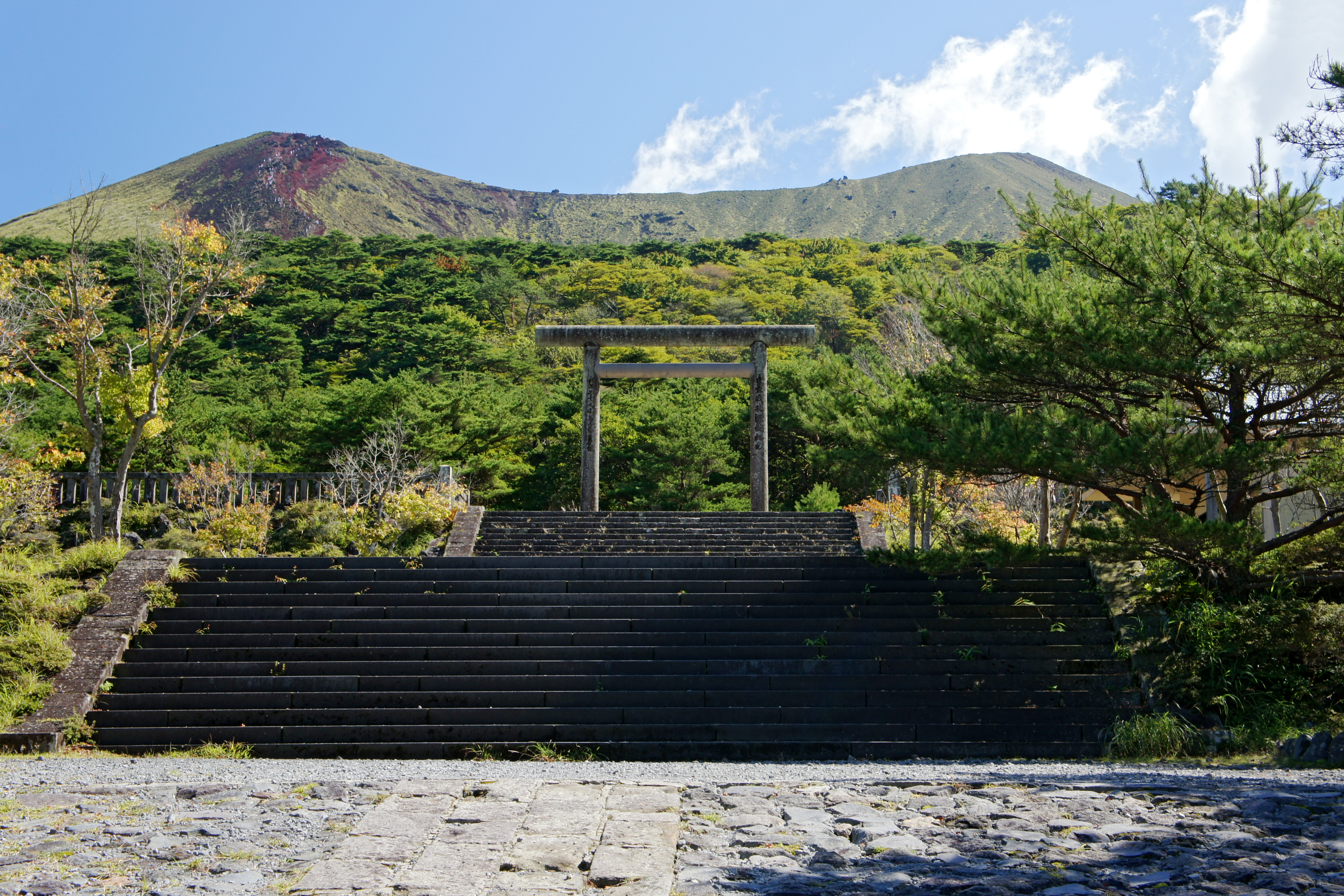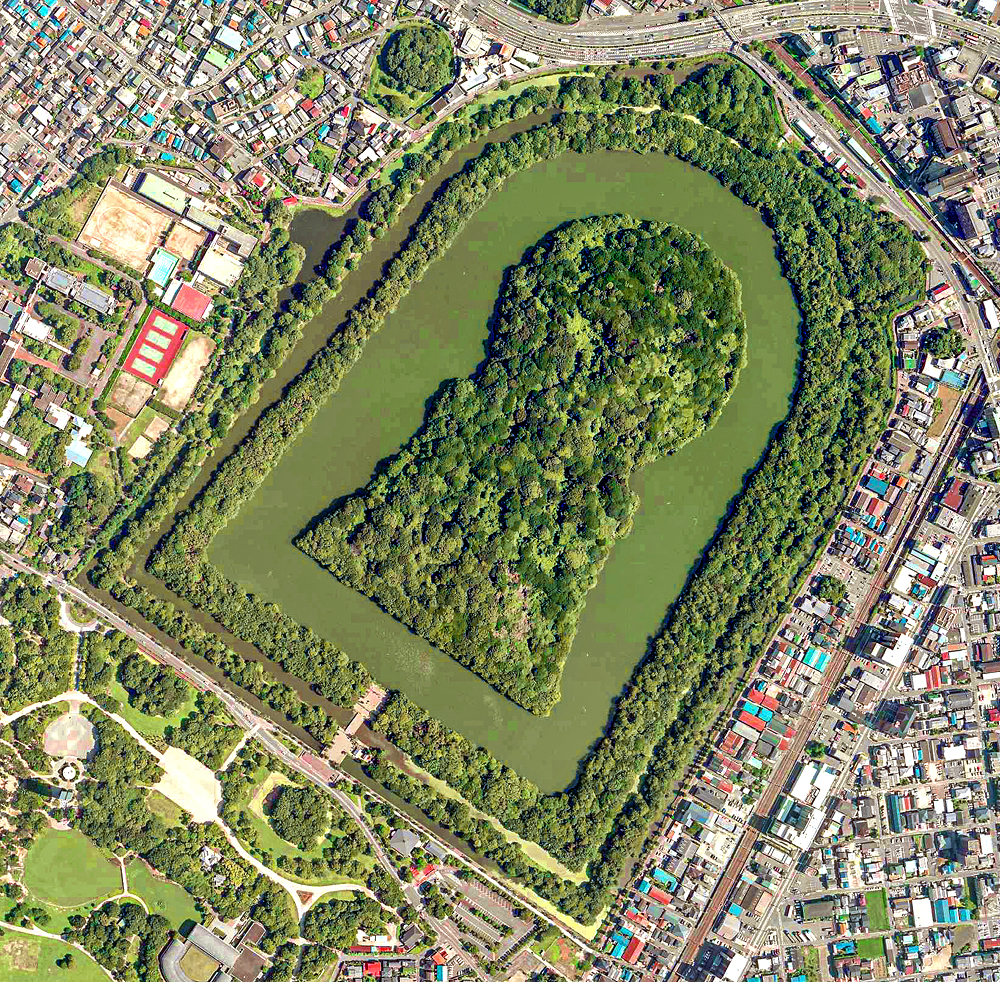|
Kōzu-gū
Kōzu-gū is a Shinto Shrine in Ōsaka, Japan. It honors Emperor Nintoku. He was the 16th emperor. He reigned from 313 to 399. Emperor Nintoku named the area Kōzu-gū. This area is now known as Ōsaka. One day, Emperor Nintoku looked at the city and he didn't see much smoke from cooking in the city. This meant the people were poor. He removed all taxes to help them. This made him very popular. In 866, Emperor Seiwa became interested in this place. He was the 56th emperor. He reigned from 858 to 876. He ordered a search for the old capital's ruins. A shrine was built on the site. This became the Kōzu-gū shrine. During Emperor Ōgimachi's reign, changes happened. He reigned from 1577 to 1586. Toyotomi Hideyoshi was building Ōsaka Castle then. The shrine was in the castle area. In 1583, the shrine's shintai was moved. It went to Himekoso Jinja. This is Kōzu-gū's current location. In 1872, Kōzu-gū became a Prefectural Shrine. In 1921, the was made. It mentions Emperor Ni ... [...More Info...] [...Related Items...] OR: [Wikipedia] [Google] [Baidu] |
Beppyo Shrines
A ''Beppyō'' shrine () is a category of Shinto shrine, as defined by the Association of Shinto Shrines. They are considered to be remarkable in some way, and thus given a higher status than other shrines. It is considered the successor to the more detailed modern system of ranked Shinto shrines. Overview With the abolition of the state administration of shrines on February 2, 1946, the official system of shrine rankings (modern shrine rankings system) was abolished, and another system was established in 1948 to replace it. After the abolition of the shrine rating system, all shrines were considered to be on an equal footing (except for Ise Shrine). However, since it would be inconvenient to treat the former official national shrines and some of the larger shrines in the same way as ordinary shrines with regard to the advancement and retirement of Shinto priests, the "Regulations Concerning the Advancement and Retirement of Officials and Employees" stipulate that special trea ... [...More Info...] [...Related Items...] OR: [Wikipedia] [Google] [Baidu] |
Shinto
, also called Shintoism, is a religion originating in Japan. Classified as an East Asian religions, East Asian religion by Religious studies, scholars of religion, it is often regarded by its practitioners as Japan's indigenous religion and as a nature religion. Scholars sometimes call its practitioners ''Shintoists'', although adherents rarely use that term themselves. With no central authority in control of Shinto, there is much diversity of belief and practice evident among practitioners. A polytheism, polytheistic and animism, animistic religion, Shinto revolves around supernatural entities called the (神). The are believed to inhabit all things, including forces of nature and prominent landscape locations. The are worshipped at household shrines, family shrines, and Shinto shrine, ''jinja'' public shrines. The latter are staffed by priests, known as , who oversee offerings of food and drink to the specific enshrined at that location. This is done to cultivate harmony ... [...More Info...] [...Related Items...] OR: [Wikipedia] [Google] [Baidu] |
Osaka Castle
is a Japanese castle in Chūō-ku, Osaka, Chūō-ku, Osaka, Japan. The castle is one of Japan's most famous landmarks and played a major role in the unification of Japan during the sixteenth century of the Azuchi–Momoyama period. Layout The inner keep of Osaka Castle is situated on a plot of land roughly one square kilometre. It is built on two raised platforms of landfill supported by sheer walls of cut rock, using a technique called burdock piling, each overlooking a moat. The keep is five stories on the outside and eight stories on the inside and built atop a tall stone foundation to protect its occupants from attackers. The main keep is surrounded by a series of moats and defensive fortifications. The castle has two moats (an inner and an outer one). The inner castle moat lies within the castle grounds and consists of two types: wet (northern-easterly) and dry (south-westerly). The outer moat meanwhile surrounds the entire castle premise, denotes the castle's outer limi ... [...More Info...] [...Related Items...] OR: [Wikipedia] [Google] [Baidu] |
Hachiman Shrines
In Japanese religion, ''Yahata'' (八幡神, ancient Shinto pronunciation) formerly in Shinto and later commonly known as Hachiman (八幡神, Buddhism in Japan, Japanese Buddhist pronunciation) is the Shinbutsu-shūgō, syncretic divinity of archery and war, incorporating elements from both Shinto and Buddhism in Japan, Buddhism. His title that was given Great Bodhisattva of National Protection and Marvelous Spirit Power (護国霊験威力神通大菩薩). The first mention of this kami is found in the Shoku Nihongi as it contains the information that offerings were sent 794 CE to Hachiman shrines on the occasion of conflict with the kingdom Silla in Korea.Picken, Stuart (1994): Essentials of Shinto: An Analytical Guide to Principle Teachings. Green Wood Press, Westport. P. 103. In Shinto religion, he is mortally Emperor Ōjin (応神天皇, ''Ōjin Tennō'') by birth who reigned in the 3rd–4th century and the son of Empress Jingū (神功皇后, ''Jingū-kōgō''), later b ... [...More Info...] [...Related Items...] OR: [Wikipedia] [Google] [Baidu] |
Shinto Shrines In Osaka
, also called Shintoism, is a religion originating in Japan. Classified as an East Asian religion by scholars of religion, it is often regarded by its practitioners as Japan's indigenous religion and as a nature religion. Scholars sometimes call its practitioners ''Shintoists'', although adherents rarely use that term themselves. With no central authority in control of Shinto, there is much diversity of belief and practice evident among practitioners. A polytheistic and animistic religion, Shinto revolves around supernatural entities called the (神). The are believed to inhabit all things, including forces of nature and prominent landscape locations. The are worshipped at household shrines, family shrines, and ''jinja'' public shrines. The latter are staffed by priests, known as , who oversee offerings of food and drink to the specific enshrined at that location. This is done to cultivate harmony between humans and and to solicit the latter's blessing. Other common r ... [...More Info...] [...Related Items...] OR: [Wikipedia] [Google] [Baidu] |
Shinto Shrines In Japan
, also called Shintoism, is a religion originating in Japan. Classified as an East Asian religions, East Asian religion by Religious studies, scholars of religion, it is often regarded by its practitioners as Japan's indigenous religion and as a nature religion. Scholars sometimes call its practitioners ''Shintoists'', although adherents rarely use that term themselves. With no central authority in control of Shinto, there is much diversity of belief and practice evident among practitioners. A polytheism, polytheistic and animism, animistic religion, Shinto revolves around supernatural entities called the (神). The are believed to inhabit all things, including forces of nature and prominent landscape locations. The are worshipped at household shrines, family shrines, and Shinto shrine, ''jinja'' public shrines. The latter are staffed by priests, known as , who oversee offerings of food and drink to the specific enshrined at that location. This is done to cultivate harmony ... [...More Info...] [...Related Items...] OR: [Wikipedia] [Google] [Baidu] |
Katsura Bunshi VI
, known by his stage name , is a Japanese TV presenter and rakugo artist. His former stage name was . Sanshi received this name from his ''shishô'' (master) and one of the celebrated postwar Kamigata Rakugo greats, . Sanshi's "san" came from, originally, being Bunshi's third ''deshi'' (pupil) and "shi" came from the second half of ''shisho''s stage name. Sanshi succeeded his ''shisho'''s stage name in 2012. Earlier years Sanshi was born in Higashi-ward, Sakai, Osaka on 16 July 1943. His father died when he was an 11-month-old baby. Despite early unfortunate circumstances, his efforts in the entertainment business have brought him success. Youth Sanshi entered Kansai University (Faculty of commerce), after graduating from Ichioka Commercial High School in Osaka. He immediately gained fans at University with his storytelling and humor, though he had no professional careers. After university, Sanshi entered the artistic school or Katsura Bunshi V and later signed with agen ... [...More Info...] [...Related Items...] OR: [Wikipedia] [Google] [Baidu] |
Rakugo
is a form of Japanese verbal comedy, traditionally performed in '' yose'' theatres. (Bibliographyvolume 38(1) The lone sits on a raised platform, a . Using only a and a as props, and without standing up from the seiza sitting position, the rakugo artist depicts a long and complicated comical (or sometimes sentimental) story. The story always involves the dialogue of two or more characters. The difference between the characters is depicted only through change in pitch, tone, and a slight turn of the head. Description The speaker is in the middle of the stage, and his purpose is to stimulate the general hilarity with tone and limited, yet specific body gestures. The monologue always ends with a narrative stunt ([...More Info...] [...Related Items...] OR: [Wikipedia] [Google] [Baidu] |
Toyotomi Hideyoshi
, otherwise known as and , was a Japanese samurai and ''daimyō'' (feudal lord) of the late Sengoku period, Sengoku and Azuchi-Momoyama periods and regarded as the second "Great Unifier" of Japan.Richard Holmes, The World Atlas of Warfare: Military Innovations that Changed the Course of History, Viking Press 1988. p. 68. Although he came from a peasant background, his immense power earned him the rank and title of and , the highest official position and title in the nobility class. He was the first person in history to become a ''Kampaku'' who was not born a noble. He then passed the position and title of ''Kampaku'' to his nephew, Toyotomi Hidetsugu. He remained in power as , the title of retired ''Kampaku'', until his death. It is believed, but not certain, that the reason he refused or could not obtain the title of , the leader of the warrior class, was because he was of peasant origin. Hideyoshi rose from a peasant background as a Affinity (medieval), retainer of the pr ... [...More Info...] [...Related Items...] OR: [Wikipedia] [Google] [Baidu] |
Emperor Nintoku
, also known as was the 16th Emperor of Japan, according to the traditional order of succession. Due to his reputation for goodness derived from depictions in the Kojiki and Nihon Shoki, he is sometimes referred to as the . While his existence is generally accepted as fact, no firm dates can be assigned to Nintoku's life or reign. He is traditionally considered to have reigned from 313 to 399, although these dates are doubted by scholars. Legendary narrative The Japanese have traditionally accepted Nintoku's historical existence, and a mausoleum (''misasagi'') for Nintoku is currently maintained. The following information available is taken from the pseudo-historical ''Kojiki'' and ''Nihon Shoki'', which are collectively known as or ''Japanese chronicles''. These chronicles include legends and myths, as well as potential historical facts that have since been exaggerated and/or distorted over time. The ''Kiki'' states that Nintoku was born to Nakatsuhime no Mikoto (仲姫命) ... [...More Info...] [...Related Items...] OR: [Wikipedia] [Google] [Baidu] |
Emperor Ōgimachi
was the 106th Emperor of Japan, according to the traditional order of succession. He reigned from November 17, 1557, to his abdication on December 17, 1586, corresponding to the transition between the Sengoku period of the Muromachi bakufu and the dawn of the new Azuchi–Momoyama period. His personal name was Michihito (方仁).Titsingh, I. (1834). ''Annales des empereurs du Japon'', p. 383. Genealogy Ōgimachi was the first son of Emperor Go-Nara. * Lady-in-waiting ( ''Naishi-no-Suke''): Madenokōji (Fujiwara) Fusako (万里小路 房子; d.1580) later Seiko-in (清光院), Madenokōji Hidefusa's daughter ** Second daughter: Princess Eikō (1540–1551; 永高女王) ** Third daughter (b.1543) **Eldest son: , also known as Prince Sanehito and posthumously named Yōkwōin ''daijō-tennō''. Masahito's eldest son was who became Emperor Go-Yōzei.Ponsonby-Fane, ''Imperial House'', p. 424; this Imperial Prince was enshrined in '' Tsukinowa no misasagi'' at Sennyū-ji. Go-Yōz ... [...More Info...] [...Related Items...] OR: [Wikipedia] [Google] [Baidu] |







